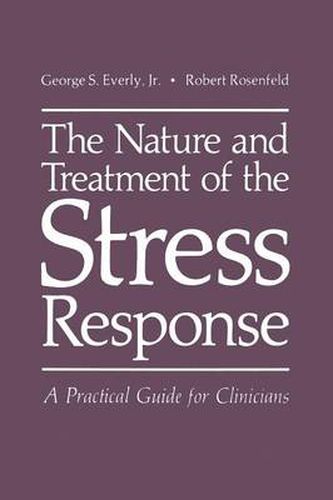Readings Newsletter
Become a Readings Member to make your shopping experience even easier.
Sign in or sign up for free!
You’re not far away from qualifying for FREE standard shipping within Australia
You’ve qualified for FREE standard shipping within Australia
The cart is loading…






This title is printed to order. This book may have been self-published. If so, we cannot guarantee the quality of the content. In the main most books will have gone through the editing process however some may not. We therefore suggest that you be aware of this before ordering this book. If in doubt check either the author or publisher’s details as we are unable to accept any returns unless they are faulty. Please contact us if you have any questions.
Barely more than twenty years ago the inquiry into the nature and implications of the psychophysiologic stress response seemed to be restricted to laboratory animals. Today, however, scientists from a wide range of disciplines are studying stress and its implications for human health and disease. This may be because our technical ability actually to measure the phenomenon has increased, as has our understanding of human psychophysiology. Just as important, how ever, may be the fact that we have entered a new era of disease. According to Kenneth Pelletier, we have entered upon an era in which stress plays a dominant role in the determination of human disease. Pelletier has stated that up to 90% of all disease may be stress-related. Whether this estimation seems inflated or not, the fact remains that clinicians of all kinds, including physicians, psychologists, physical therapists, social workers, and counselors, are daily being confronted with clients suffering from excessive psychophysiologic stress arousal. This fact has created a need to know more about the stress response and its treatment. Although more and more health-care professionals are directly or indirectly working with clients who manifest excessive stress, there has been no text previously written which attempted to condensE’ between the covers of a single volume a practical, clinically compre hensive discussion of what stress is (as best we currently understand it) and how to treat it when it becomes excessive.
$9.00 standard shipping within Australia
FREE standard shipping within Australia for orders over $100.00
Express & International shipping calculated at checkout
This title is printed to order. This book may have been self-published. If so, we cannot guarantee the quality of the content. In the main most books will have gone through the editing process however some may not. We therefore suggest that you be aware of this before ordering this book. If in doubt check either the author or publisher’s details as we are unable to accept any returns unless they are faulty. Please contact us if you have any questions.
Barely more than twenty years ago the inquiry into the nature and implications of the psychophysiologic stress response seemed to be restricted to laboratory animals. Today, however, scientists from a wide range of disciplines are studying stress and its implications for human health and disease. This may be because our technical ability actually to measure the phenomenon has increased, as has our understanding of human psychophysiology. Just as important, how ever, may be the fact that we have entered a new era of disease. According to Kenneth Pelletier, we have entered upon an era in which stress plays a dominant role in the determination of human disease. Pelletier has stated that up to 90% of all disease may be stress-related. Whether this estimation seems inflated or not, the fact remains that clinicians of all kinds, including physicians, psychologists, physical therapists, social workers, and counselors, are daily being confronted with clients suffering from excessive psychophysiologic stress arousal. This fact has created a need to know more about the stress response and its treatment. Although more and more health-care professionals are directly or indirectly working with clients who manifest excessive stress, there has been no text previously written which attempted to condensE’ between the covers of a single volume a practical, clinically compre hensive discussion of what stress is (as best we currently understand it) and how to treat it when it becomes excessive.